Mathematics Achievement Remains an Area of Focus but Sees Gradual Growth Over Time with Some School Boards Showing Significant Increases; Literacy Achievement Remains High but Shows Some Decline
Provincial and local results for students in English- and French-Language Schools
News
The Education Quality and Accountability Office (EQAO) has released provincial, school- and board-level data from its 2023–2024 assessments, which marks the third consecutive year of the agency’s reporting on the student achievement results of its online provincial assessments. EQAO data provide an independent snapshot that shows whether students are meeting curriculum expectations in reading, writing and mathematics at key stages of their education. The results also provide additional insights into students’ attitudes and perceptions related to their learning.
More than 570 000 students across the province completed EQAO assessments at the elementary and secondary levels of the English- and French-language school systems during the 2023–2024 school year. EQAO is reporting on achievement results as well as data from student questionnaires. This provides contextual and attitudinal information about student learning to build a fuller picture of learners’ contexts and the factors that influence achievement.
While mathematics results are generally stable relative to last year’s, many students across Ontario are meeting the provincial standard, or are very close to meeting the provincial standard. Several English- and French-language school boards across Ontario saw significant gains in students’ mathematics achievement in 2023–2024, thanks to a combination of factors. These include tailored and innovative strategies developed locally by educators with the support of the provincial Math Action Team and board math leads and EQAO’s School Support and Outreach staff. Recently implemented plans across schools and boards have started strengthening students’ mathematics skills and are encouraging positive attitudes toward mathematics in numerous schools. Later this year, to inform best practices in student learning across Ontario, EQAO will share approaches educators used that made a marked difference in student achievement and attitudes.
EQAO is reporting assessment data on its website through an individual school and school board search function and the EQAO data reporting tool, a platform that leverages interactive and user-friendly dashboards that educators, parents and guardians and the public can access to view assessment and questionnaire data at the provincial and local levels.
EQAO’s evidence-based data can be analyzed by educators across the province as they review and develop strategies to support each student’s learning journey. By making contextual, attitudinal and achievement data for each school and school board available, the agency satisfies its mandate to contribute to the accountability of Ontario’s education system and to the ongoing conversation about student learning and achievement.
Assessment Data and Observations
Assessment results from the previous two school years are provided along with those from 2023–2024 to show trends in achievement and attitudes from year to year. Such analyses of results contribute to a better understanding of student learning over time.
Students in English-Language Schools
Assessments of Reading, Writing and Mathematics, Primary and Junior Divisions
The Assessments of Reading, Writing and Mathematics, Primary Division (Grade 3) and Junior Division (Grade 6) are computer-based assessments that measure the reading, writing and mathematics knowledge and skills students are expected to have learned by the end of Grades 3 and 6 according to The Ontario Curriculum.
Primary Division (Grade 3)
According to the data from 2023–2024, Grade 3 student achievement results, which are given in relation to the provincial standard (Levels 3 and 4), have decreased in reading and writing relative to those from 2022–2023, and have increased in mathematics.
The three-year trend shows a decrease in the percentage of students meeting the provincial standard in reading and writing, and an increase in mathematics.
Percentage of Grade 3 students who met the provincial standard
Reading
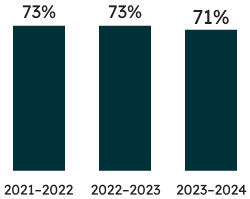
Writing
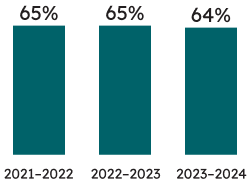
Mathematics
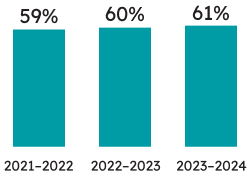
Learners’ Context
Percentage of Grade 3 students who indicated that
Reading
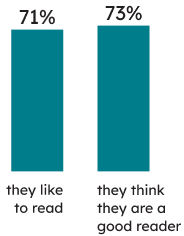
Writing
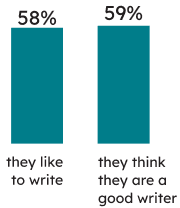
Mathematics
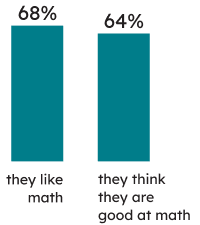
Junior Division (Grade 6)
According to the data from 2023–2024, Grade 6 student achievement results, which are given in relation to the provincial standard (Levels 3 and 4), have decreased in reading and writing relative to those in 2022–2023, and have remained the same in mathematics.
The three-year trend shows a decrease in the percentage of students meeting the provincial standard in reading and writing, and an increase in mathematics.
Percentage of Grade 6 students who met the provincial standard
Reading
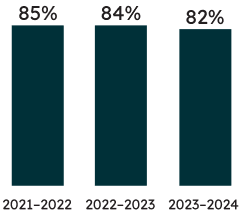
Writing

Mathematics
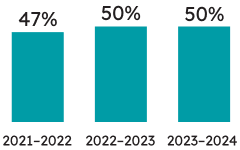
Learners’ Context
Percentage of Grade 6 students who indicated that
Reading
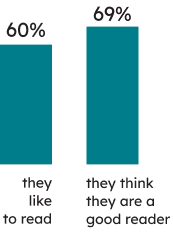
Writing
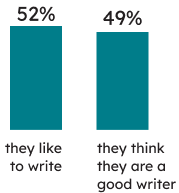
Mathematics
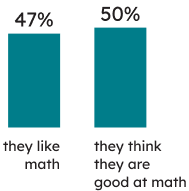
Grade 9 Assessment of Mathematics
The Grade 9 Assessment of Mathematics is a multi-stage computer adaptive assessment that measures the mathematics knowledge and skills students are expected to have learned by the end of the Grade 9 mathematics course according to The Ontario Curriculum.
According to the data from the 2023–2024 EQAO assessments, Grade 9 student achievement results, which are given in relation to the provincial standard (Levels 3 and 4), have remained stable relative to those in 2022–2023.
The three-year trend shows that the percentage of students meeting the provincial standard has increased.
Percentage of Grade 9 students who met the provincial standard in mathematics
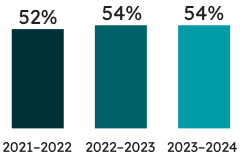
Learners’ Context
Percentage of Grade 9 students who indicated that
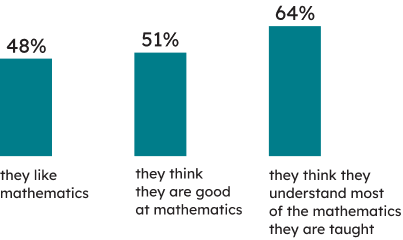
Ontario Secondary School Literacy Test (OSSLT)
The OSSLT is a linear test design computer assessment that measures whether students are meeting the minimum standard for literacy across all subjects up to the end of Grade 9 according to The Ontario Curriculum. First-time eligible students typically take the assessment in Grade 10.
According to the data from 2023–2024, overall success rates on the OSSLT are high, showing stability in students’ acquisition of the literacy knowledge and skills stated in The Ontario Curriculum.
The three-year trend shows that success rates have increased.
It is encouraging to note that the achievement gap between the success rates of students taking the applied course and those taking the academic course has been steadily narrowing over the past three years, although the achievement gap between academic and applied students remains an area of concern.
Percentage of students who wrote the OSSLT and were successful
First-time eligible students
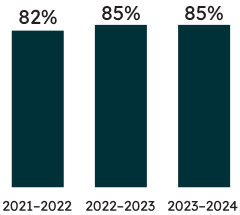
Previously eligible students
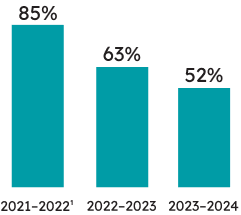
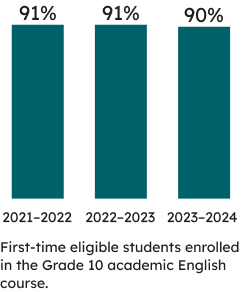
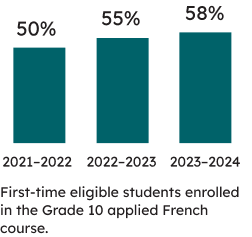
Learners’ Context
Percentage of OSSLT students who indicated that
Reading
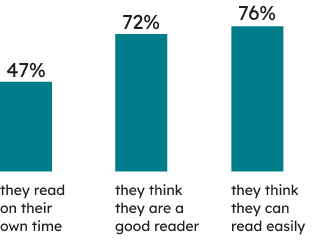
Writing
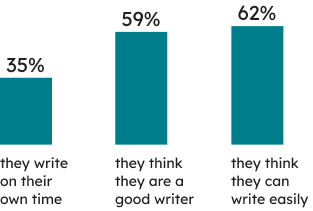
1There was a considerable difference between the size and composition of the 2021‒2022 previously eligible cohort and the size and composition of this cohort in both 2022–2023 and this school year due to the pandemic-related disruption to the tests in 2019‒2020 and 2020‒2021.
Students in French-Language Schools
Tests en lecture, écriture et mathématiques, cycles primaire et moyen2
The Test en lecture, écriture et mathématiques, cycle primaire (Grade 3) and cycle moyen (Grade 6), are computer-based assessments that measure the reading, writing and mathematics knowledge and skills students are expected to have learned by the end of Grades 3 and 6 according to The Ontario Curriculum.
Cycle primaire (Grade 3)
According to the data from 2023–2024, Grade 3 student achievement results, which are given in relation to the provincial standard (Levels 3 and 4), have increased in reading and mathematics and decreased in writing relative to those from 2022–2023.
The three-year trend shows an increase in the percentage of students meeting the provincial standard in reading and in mathematics, and stability in writing.
Percentage of Grade 3 students who met the provincial standard:
Reading
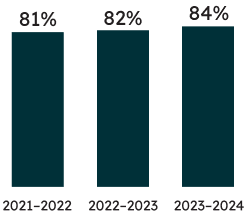
Writing
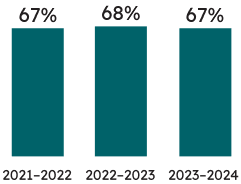
Mathematics
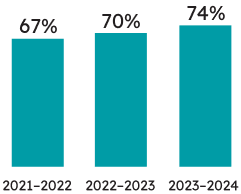
Learners’ Context
Percentage of Grade 3 students who indicated that
Reading
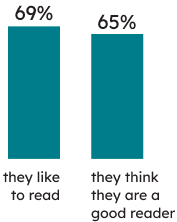
Writing
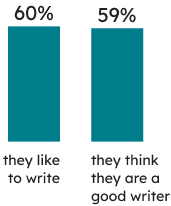
Mathematics
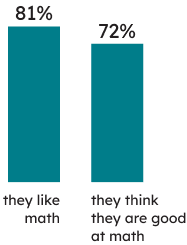
2 The name of each assessment remains in French, since the French and English assessments are distinct in their content and the curricula they cover.
Cycle moyen (Grade 6)
According to the data from 2023–2024, Grade 6 student achievement results, which are given in relation to the provincial standard (Levels 3 and 4), are the same in reading relative to those in 2022–2023, have decreased in writing and have increased in mathematics.
The three-year trend shows an exceptionally high percentage of students meeting the provincial standard in reading, a decrease in writing and an increase in mathematics.
Percentage of Grade 6 students who met the provincial standard
Reading
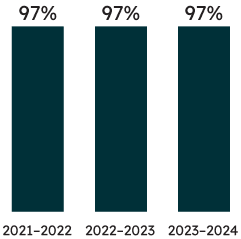
Writing
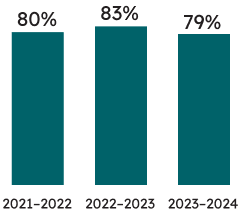
Mathematics
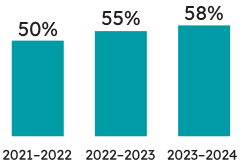
Learners’ Context
Percentage of Grade 6 students who indicated that
Reading
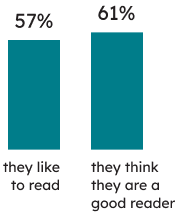
Writing
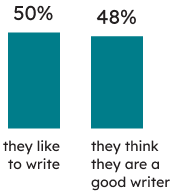
Mathematics
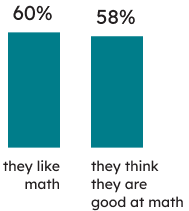
Test de mathématiques, 9e année
The Test de mathématiques, 9e année is a multi-stage computer adaptive assessment that measures the mathematics knowledge and skills students are expected to have learned by the end of the Grade 9 mathematics course according to The Ontario Curriculum.
According to the data from the 2023–2024 EQAO assessments, Grade 9 student achievement results, which are given in relation to the provincial standard (Levels 3 and 4), have increased relative to those from 2022–2023.
The three-year trend shows an increase in the percentage of students meeting the provincial standard.
Percentage of Grade 9 students who met the provincial standard in mathematics
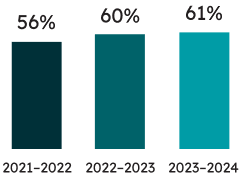
Learners’ Context
Percentage of Grade 9 students who indicated that
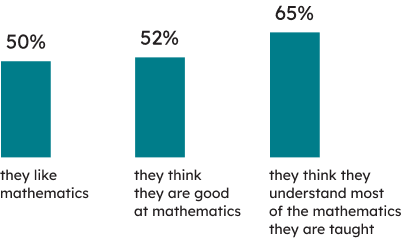
Test provincial de compétences linguistiques (TPCL)
The TPCL is a linear test design computer assessment that measures whether students are meeting the minimum standard for literacy across all subjects according to The Ontario Curriculum. First-time eligible students typically take the assessment in Grade 10.
According to the data from 2023–2024, overall success rates on the TPCL are high, showing stability in students’ acquisition of the literacy knowledge and skills in The Ontario Curriculum.
The three-year trend shows that success rates have increased.
It is encouraging to note that the achievement gap between the success rates of students taking the applied course and those taking the academic course has been steadily narrowing over the past three years, although the achievement gap remains an area of concern.
Percentage of students who wrote the TPCL and were successful
First-time eligible students
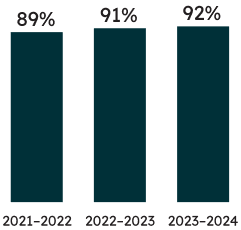
Previously eligible students
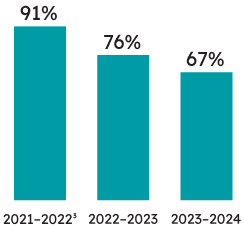
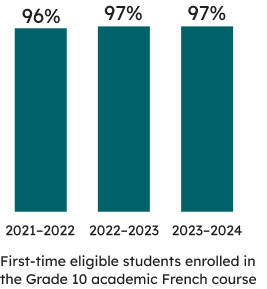
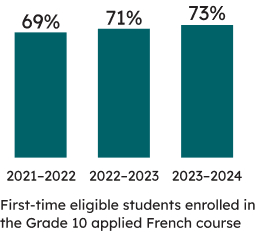
Learners’ Context
Percentage of TPCL students who indicated that
Reading
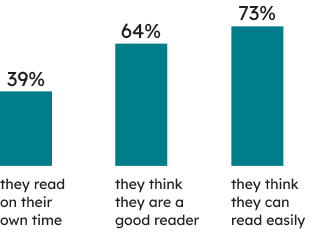
Writing
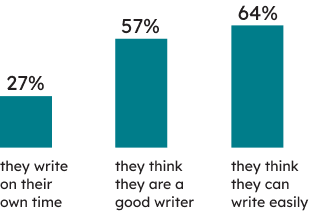
3There was a considerable difference between the size and composition of the 2021‒2022 previously eligible cohort and the size and composition of this cohort in both 2022–2023 and this school year due to the pandemic-related disruption to the tests in 2019‒2020 and 2020‒2021.
QUOTES

“EQAO contributes to the accountability of our public education system through assessments that are administered in elementary and secondary schools across the province. EQAO’s modernized assessments serve the education community and other partners by producing evidence-based data that inform Ontarians on how students are doing in their learning year after year. Access to EQAO assessment data and appropriate use of this information is an important element of our collective support of students as they progress on their learning journey.”

“Each year, EQAO assessment and questionnaire results contribute insights into student learning throughout Ontario. Having completed the third administration of its provincial online assessments, EQAO is able to release achievement and contextual data that showcase trends over three years. The data at both the elementary- and the secondary-school levels show that mathematics achievement has been stable or growing since last year; this trend appears over three years as well. Reading achievement at the elementary-school level is high and shows an encouraging stability over time, while writing achievement deserves more attention. Closing learning gaps remains the ultimate goal of everyone invested in education. EQAO data and outreach help develop and strengthen initiatives that support students locally and system-wide, as assessment information enhances our understanding of students’ needs and strengths. The additional support that year-to-year data provide to parents and guardians, educators and policy-makers can lead to the development of effective plans of action that will assist every child and youth on their education journey and prepare for successful outcomes for all.”
Links
For further information, please contact
Sophie Auclair
Senior Communications Officer


